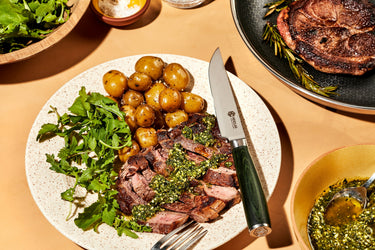The 5 Best Steak Cuts: Explained

As with all things culinary, there’s no empirical answer for what is best, whether you’re wondering what the best steak cuts are or what the best way to cook eggs is. One’s “best” is another’s “worst,” and that subjectivity leads to wonderful innovations in the world of food. That being said, it’s helpful to know about the 5 most common cuts of steak, since they’re the ones you’re most likely to come across at the grocery store. Looking to branch out beyond the same-old cuts of steak? Below you’ll also find out about 6 other cuts of steak worth trying.
What are the 5 best steak cuts?
When it comes to steak, the Venn diagram of what is most popular and what is best overlap generously. Use this list as a starting point for your next visit to the butcher.
Coming from the narrow end of the cow’s tenderloin muscle, filet mignon is the cut most often used for steak au poivre. Because this muscle isn’t used much, it is incredibly tender. They tend to be higher priced because there are only a few pieces of filet mignon from each cow. The circular, small cuts (mignon is French for “small,” after all) cook quickly. Don’t step away from the stove when cooking filet mignon—because this cut is low fat, it can become dry if cooked too long.
The name of this steak points to its location: it comes from the center (or, eye) of the cow’s rib section, which naturally has more intramuscular fat. This means the meat—whether bone-in or boneless—has beautiful marbling, which allows the meat to be cooked longer without drying out. The natural fattiness means the meat is tender, juicy, and has a lot of flavor. You’ll also see ribeye called rib-eye, Delmonico, Spencer, beauty, sarket, or Scotch. Prime rib is a several-rib section of the same area on the cow.
You’ll find the New York strip steak on the opposite side of the cow as the tenderloin, in the loin area. NY strip steaks contain a generous amount of marbling, though less than a ribeye steak. Usually boneless, the New York strip has a thick fat cap around the meat. This allows it to stay juicy during cooking, but can be quite chewy, so you may want to remove it before eating. New York strip steak is also called Kansas City strip or top sirloin.
Both the T-bone and porterhouse steaks come from the same section of the cow: the short loin. The T-shape comes from the fact that it’s a cross section of the short loin, combining pieces of tenderloin on one side and NY strip on the other. T-bones are thinner than porterhouse steaks—the USA says that it has to be at least ½-inch thick.
According to the USDA, a porterhouse steak must be at least 1¼-inches thick. It makes a great steak for sharing, thanks to its generous size and mix of NY strip steak and tenderloin. (The only difference between the t-bone and porterhouse is the thickness.)
6 other steak cuts worth trying
- Flank steak: Great for marinating, this low-fat cut comes from the area that runs along the cow’s abdomen.
- Bottom sirloin steak: Also referred to as sirloin butt or thick flank, this cut comes from the lower area of the sirloin section of the cow. Opt for roasting rather than searing this cut.
- Skirt steak: Though it looks similar to flank steak, skirt steak comes from the diaphragm muscles. It’s delicious marinated or cooked quickly over high heat
- Hanger steak:
- Flat iron steak: Flat iron steaks come from the shoulder area of the cow and boasts tender meat and a deep, beefy flavor.
- Tri-tip steak: Coming from the bottom sirloin section of the cow, this leaner cut has a distinct, triangular shape.
How to tell if a steak cut is high-quality
When you’re at the market assessing which meat to buy, look for plump, juicy meat that is vibrant red. Any fat should be bright white, whether in the fat cap or marbling. Meat labeled prime grade will be the highest quality, while choice and select cuts generally have less marbling and aren’t as tender.
What’s the best pan to cook a steak with?
To cook a steak well, you’ll want a heavy-duty pan that distributes heat evenly. For a steak that serves 1 or 2, opt for a 10-inch pan, if you’re cooking two steaks or a big cut like a porterhouse, use a 12-inch pan.





